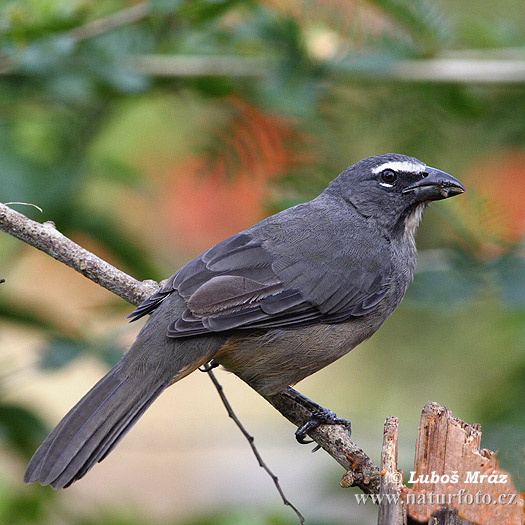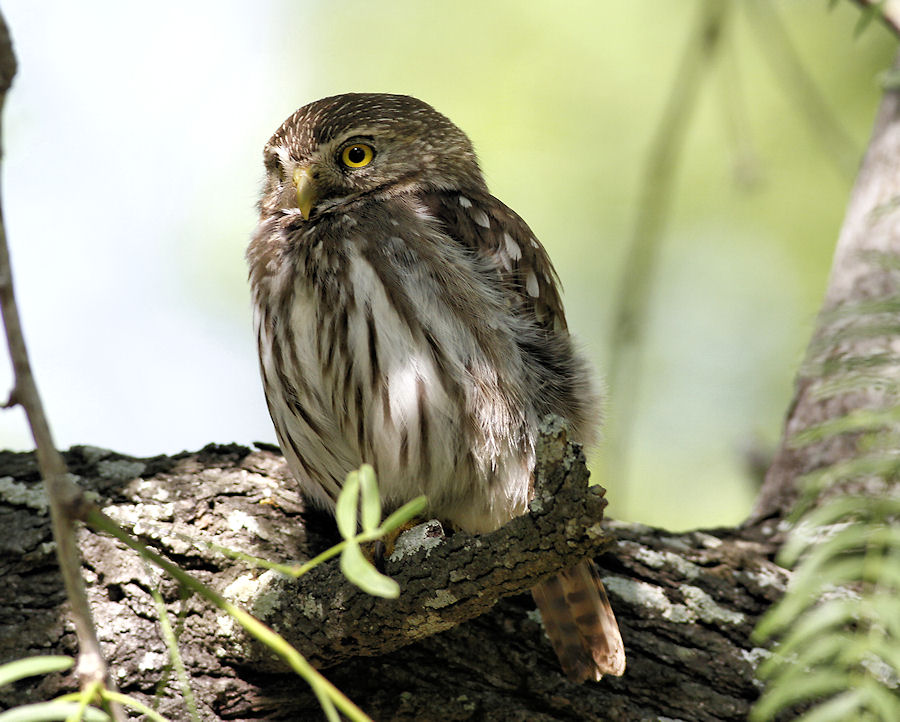Today Mom, me and my little brother drove off to visit my other grandmother, for my mom and
her mom needed to talk about some stuff and go to the bank (in which we almost died of boredom) to check some things. Before this, we ate lunch on her house and played with her Schnautzer. I went out to her yard, and looked at a tree from her neighbor's house. I spotted movement, and immedietly recognized the bird. A Saltator was there, jumping about the tree. I whispered to my little brother, who was near me: "Please, Daniel, run to the car and snatch my binoculars!" He went in, walked to my mom, asked her for the keys, ran to the car, opened it, grabbed my binocs and then ran back, talked to my mother for a moment and watched TV, and then finally gave them to me. It felt like
ages to me, especially because the saltator jumped farther and farther away from me, There was also some type of warbler near, but it flew away or hid before I could take a good look at it, so I focused on the saltator.
For the time I had raised the binoculars to my eyes, the saltator did not show its front side with the particular markings that difference each of the four species of saltators that ocurr in Costa Rica from each other. However, it was exactly this that helped me come to a conclusion on what type of saltator it was.
The Buff-Throated Saltator (
Saltator Maximus) ocurrs in almost the whole country. However, the saltator I saw did not have the bright-olive colored back of this saltator, instead it was darkish gray.
 |
| Buff-Throated saltators have a bright-olive back, nape, tail and wings |
Streaked Saltators occur in the southernmost part of the country, and as their name suggests they have streaked breasts. The one I saw did not have a streaked breast, just in case it had accidentally come to a suburban San José home.
 |
| Streaked saltators are, well, streaked! |
The Black-Headed saltator (
Saltator Atriceps) is very similar to the Buff-Throated saltator. The main difference between them is that the Black-headed Saltator has a heavier bill, white (not buff) throat and less-defined eyebrows (supercillium). Also, black-headed saltators occur in the Caribbean Slope, not San José.
_(1).jpg) |
| Black-Headed Saltator. Compare with the Buff-Throated Saltator |
So, what type of saltator was the mystery saltator after all? The Grayish Saltator (
Saltator coerulescens)!
Grayish saltators fit in with what I saw:
-Gray back and body
-White Eyebrows
 |
| Grayish Saltator! |
I spent some time trying to figure this out. It was the gray back what confirmed the Saltator's identity, but I wasn't that sure before I pointed out this markings to myself.
I have never seen a saltator (or at least been able to identify one) in my life! This was truly exciting!
Perhaps one of the funnest parts of birdwatching is doing this kind of detective work. Sometimes its frustrating, but other one ends up with a triumphant sensation :) .
_______________________________________________________________________
ES
Hoy, mi mamá, yo, y mi hermanito menor manejamos hasta la casa de mi otra abuela para que ella y mi madre pudieran hablar de unos asuntos e ir al banco (en el que por cierto casi morimos de aburrimiento) para revisar unas cosas. Antes, almorzamos en su casa y jugamos con su Schnautzer. En un momento fuí al patio de su casa y miré al árbol de los vecinos de la par. Noté un movimiento, y me encontré mirando a un Saltador (o Saltator) saltando por las ramas del árbol. Rápidamente, le susurré a mi hermanito menor, que estaba cerca mío: "¡Dani, porfa tráigame los binoculares que están en el carro!" Él entró devuelta a la casa, le pregunto a mi madre por las llaves, corrió al carro, lo abrió, sacó los binoculares, cerró el carro, corrió devuelta a la casa, paró un momento a darle las llaves a mi mamá y a ver la tele y finalmente me dió los binoculares ¡Dios mío, sentí como si pasaran años mientra esperaba viendo cómo el ave se alejaba poco a poco de mi vista! También había otro pájaro, una reinita desconocida, andando por el árbol. Esta después voló o se escondió de mi vista, dejándome sin poder saber de qué tipo era, así que decidí concentrarme en el saltador.
Para el momento en el que había alzado los binoculares a mis ojos, solamente podía ver el lomo y cola del saltador, dejando fuera de mi vista la cabeza y pecho, en los cuales están las marcas que identifican a un saltador de las otras cuatro especies que ocurren en Costa Rica. Sin embargo, fue exactamente esto lo que me ayudó a confirmar su especie.
El Saltador Gorgianteado (
Saltator Maximus) se encuentra en casi todo el país. Sin embargo, el saltador que vi no tenía una espalda color oliva brillante, esta era más de un color gris oscuro.
 |
| El saltador gorgianteado tiene una espalda, alas, nuca y cola olivas |
Los Saltadores Listados o Rayados (
Saltator Striatipectus) se encuentra en el extremo sur del país, pero de todos modos el ave que vi no tenía un pecho rayado, por si acaso llegó a un suburbio josefino por accidente.
 |
| El saltador rayado es, pues diay, rayado! |
El Saltador Cabecinegro (
Saltator Atriceps) es muy similar al Saltador Gorgianteado. Sin embargo, el Saltador Cabecinegro tiene una garganta blanca (no canela) tiene un pico mas grande y unas cejas (supercilio) menos definidas.
_(1).jpg) |
| Saltador Cabecinegro. Compárenlo con el Saltador Gorgianteado. |
Entonces, ¿de qué tipo era el saltador que ví? ¡Ajá, nada más que un Saltador Grisáceo (
Saltator Coerulescens)! Este saltador encaja con lo que ví:
-Espalda gris
-Cejas blancas
 |
| Saltador Grisáceo! |
Pasé un buen tiempo tratando de averiguar esto. La espalda gris fue lo que confirmó la identidad del saltador, pero no estaba tan segura hasta que me di cuenta de esta importante marca en el saltador.
Hacer esta clase de trabajo de detective es una de las razones por la cuál observo aves. Algunas veces puede ser increíblemente frustrante, pero en otras uno termina con una sensación de triunfo :) .
------------------------------
-Cristina
====================
Photos/Fotos: Buff-Throated Saltator from / Saltador Gorgianteado de
Wiki Commons. Streaked Saltator from/ Saltador Rayado de
Wiki Commons. Black-Headed Saltator/Saltador Cabecinegro de
Wiki Commons. Grayish Saltator from/Saltador Grisáceo de
NaturFoto.cz.






















_(1).jpg)

.svg/500px-Flag_of_Costa_Rica_(state).svg.png)